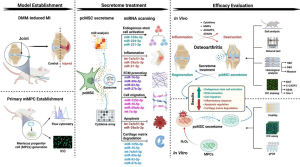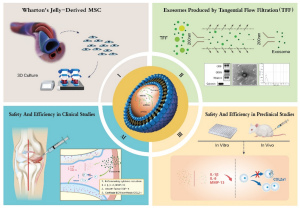Scientific Reports, 09 July 2025
A recent preclinical study demonstrated that the combination of super activated platelet lysate (sPL) and umbilical cord-derived mesenchymal stem cells (UCMSCs) significantly enhances the regeneration of thin endometrium in a rat model. The treatment resulted in histological repair, improved endometrial thickness, enhanced glandular structure, and restoration of hormonal and molecular profiles.
Model and Methods
- Animal model: Female Sprague–Dawley rats with ethanol-induced endometrial injury, simulating thin or adhesed endometrium—a common cause of infertility.
- Treatment groups: Seven experimental groups receiving sPL, UCMSCs, or combinations with carriers such as chitosan gel or extracellular matrix (ECM), followed over 21 and 42 days.
- Analyses: Included histological examination (H&E), immunohistochemistry (IHC), Western blotting, hormone quantification (ELISA), and evaluation of structural and regenerative protein expression.
Histological and Molecular Findings
Histological architecture:
- Treatment with either sPL or UCMSCs significantly increased endometrial thickness compared to the injury-only group, with clear restoration of epithelial lining and gland formation.
- The sPL group showed superior regeneration in both endometrial thickness and glandular density compared to UCMSCs alone.
Protein expression and regeneration markers:
- Immunohistochemistry revealed marked upregulation of vimentin (stromal marker), cytokeratin (epithelial marker), CD34 (angiogenesis), and cyclin D1 (proliferation).
- Western blot confirmed increased expression of CK18 and vimentin, reflecting active tissue remodeling.
Hormonal Restoration and Microenvironmental Modulation
- Levels of estradiol (E2), FSH, PDGF-BB, and TGF-β1 were restored to physiological ranges post-treatment, particularly prominent on day 42.
- sPL exhibited stronger anti-fibrotic effects than UCMSCs alone, likely through high-level release of concentrated growth factors (e.g., PDGF, TGF-β, VEGF).
- No signs of chronic inflammation or fibrosis were observed in the sPL-treated groups.
Proposed Mechanisms of Action
- sPL acts as a biologically enriched matrix, delivering high concentrations of regenerative growth factors with immunomodulatory and anti-inflammatory properties, stimulating endometrial proliferation.
- UCMSCs contribute through differentiation toward endometrial lineages, exosome release, and modulation of the uterine microenvironment.
- The synergistic combination of sPL and UCMSCs enhances both acute repair and long-term structural stability of the endometrial tissue.
Clinical Relevance and Future Potential
- Thin endometrium remains a major challenge in reproductive medicine, particularly in patients with recurrent implantation failure.
- This study supports the use of bioactive cellular + growth factor therapies to re-establish both structure and function of the endometrium, facilitating embryo implantation and successful pregnancy.
- sPL, with its scalability, storage stability, and ease of preparation, represents a safer and more standardized alternative to conventional PRP (platelet-rich plasma).
References
Meng, L. Q., Zhang, Y., Liu, C. X., Ullah, I., Zhang, T. Q., & Zhang, Y. (2025). Therapeutic potential of super activated platelet lysate (sPL) and umbilical cord mesenchymal stem cells (UCMSCs) in enhancing endometrial regeneration in rats with thin endometrium. Scientific Reports, 15(1), 24698.
Source: Scientific Reports
Link: https://www.nature.com/articles/s41598-025-10587-w#citeas








